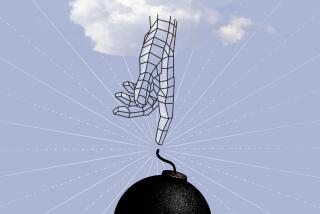Consider the Costs of Each Path to the ‘Biotech Century’
- Share via
After more than 40 years of parallel development, the information and life sciences are fusing into a single, powerful technological and economic force that is laying the foundation for the “biotech century.” The computer increasingly is being used to decipher, manage and organize the vast genetic information that is the raw resource of the new global economy.
The biotech century promises a cornucopia of genetically engineered plants and animals to feed a hungry population, genetically derived sources of energy and fiber to propel commerce and build a “renewable” society, wonder drugs and genetic therapies to produce healthier babies, eliminate human suffering and extend the human life span. But a nagging question remains: At what cost?
The new genetic commerce raises more troubling issues than any other economic revolution in history. Will the artificial creation of cloned, chimeric and transgenic animals mean the end of nature and the substitution of a “bioindustrial” world? What are the consequences for the global economy and society of reducing the world’s gene pool to patented intellectual property controlled by a handful of life-science corporations? What will it mean to live in a world where babies are genetically engineered and customized in the womb and where people are increasingly identified, stereotyped and discriminated against on the basis of their genotype? What are the risks we take in attempting to design more “perfect” human beings?
Over the past 20 years, I’ve expressed growing concern about many aspects of the emerging biotech revolution, leading many to ask if I’m simply opposed to technology. The question is not whether one is in favor or opposed, but rather, what kind of technology one favors. The biotech revolution is a good case in point. Two broad technological approaches to the biotech century are beginning to emerge, each based on very different premises.
Agriculture offers an example of these approaches. Molecular biologists are inserting genes from exotic nonfood organisms into the biological code of food crops to make them more resistant to herbicides, pests, bacteria and fungi. They envision these engineered hybrids living in a kind of genetic isolation. A growing number of environmentalists worry that the mass release of these genetically engineered plants into the environment could cause genetic pollution and irreversible damage to the biosphere.
Many ecologists, on the other hand, are using the new genomic data to better understand the many ways environmental factors affect genetic expressions and mutations in plants. They eschew the genetic engineering of plants in favor of creating a sophisticated, organic-based approach to agriculture that relies on integrated pest management, crop rotation, natural fertilization and other sustainable methods designed to make farming compatible with surrounding ecosystems.
Similarly, in medicine, many molecular biologists are focusing their research on somatic gene surgery--pumping altered genes into patients suffering from illnesses and disorders. Other researchers, however, are using the wealth of new genetic information to explore the ties between genetic mutations and environmental triggers with the hope of fashioning a more scientific approach to preventive health. They are using the new genetic science to better understand how diet, exercise and other environmental factors affect illness, with an eye toward keeping people well.
In short, one approach--the hard path--uses the new genetic science to engineer radical changes in the very blueprint of species to advance progress, while the other approach--the soft path--uses the same genetic science to create a more integrative and sustainable relationship between existing species and their environments.
Some argue that both approaches should exist side by side, each enriching the other. In reality, the commercial market favors the former approach for the obvious reason that for now, that’s where the most money can be made. Although there is a growing market for organic foods and preventive health products and services, far more money is being invested in biotech agriculture and illness-based medicine.
That could change, but it would take a profound shift in the way we think about science and its applications. However, it is not difficult to imagine a turnaround of sorts, with the more ecological and preventive health biotechnologies taking precedence.
The principal players in biotechnology might find it inconceivable that genetic engineering, with all its promise, could be rejected. Nevertheless, that could easily happen. Recall that nuclear energy, once considered the greatest power source ever developed, has been partly or largely abandoned in many countries, thanks to growing public awareness of its true financial and environmental impact. Society also could choose to accept some uses of genetic engineering and reject others. For example, one could make a solid case for genetic screening--with the appropriate safeguards--to better predict the onslaught of disabling diseases, especially those that can be prevented with early treatment. On the other hand, the use of gene therapy to make corrective changes in human sperm, eggs and embryonic cells, affecting the evolution of future generations, is far more dangerous.
It isn’t a matter of saying yes or no to the use of science itself. Rather, the question is: What kind of biotechnologies will we choose in the coming century?
We should keep open as many options as possible. This means that when choosing among alternative biotech applications, we are best served by taking the less radical, more conservative approach, the one least likely to create environmental, social and economic disruptions. “First, do no harm” is a well-established and long-revered principle in medicine.
The moment has arrived for a broad and spirited public debate over which of the two very different technological paths to the biotech century better reflects the values and sensibilities of our generation.






